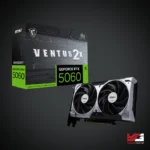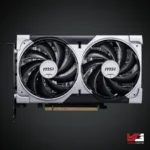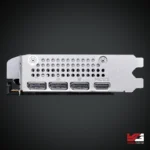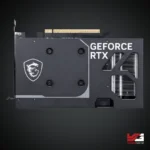




₨ 120,000
- Powered by the NVIDIA Blackwell architecture and DLSS 4
- Core Clocks:
Extreme Performance: 2535 MHz (MSI Center)
Boost: 2527 MHz - TORX Fan 5.0: Fan blades linked by ring arcs work to stabilize and maintain high-pressure airflow.
- Heat Pipes designed for efficient heat transfer, the heat pipes effectively draw thermal energy away from the GPU, improving overall cooling performance.
- Reinforcing Backplate: The reinforcing backplate features an airflow vent that allows exhaust air to directly pass through.
- MSI Center: The exclusive MSI Center software lets you monitor, tweak and optimize MSI products in real-time.
- Afterburner software takes full control with the most recognized and widely used graphics card overclocking software in the world.
In stock
RELATED PRODUCTS
MSI GeForce RTX 4060 Ti VENTUS 2X 16G OC
- WITH DLSS 3
- Game, stream, create. The GeForce RTX™ 4060 Ti lets you take on the latest games and apps with the ultra-efficient NVIDIA Ada Lovelace architecture. Experience immersive, AI-accelerated gaming with ray tracing and DLSS 3, and supercharge your creative process and productivity with NVIDIA Studio.
- Boost Clock / Memory Speed
- 2610 MHz / 18 Gbps
- 16GB GDDR6
- DisplayPort x 3 (v1.4a) HDMI™ x 1 (Supports 4K@120Hz HDR, 8K@60Hz HDR, and Variable Refresh Rate as specified in HDMI™ 2.1a)
- Dual Fan Thermal Design
- TORX Fan 4.0: A masterpiece of teamwork, fan blades work in pairs to create unprecedented levels of focused air pressure.
- Zero Frozr: The fans completely stop when temperatures are relatively low, eliminating all noise.</span>
- Metal Backplate
- Thermal pads under the sturdy flow-through metal backplate helps with cooling.
- MSI Center
- The exclusive MSI Center software lets you monitor, tweak, and optimize MSI products in real-time.
MSI GeForce RTX 5060 TI GAMING TRIO 3X 16G OC
- Powered by the NVIDIA Blackwell architecture and DLSS 4
- Core Clocks: Extreme Performance: 2662 MHz (MSI Center) Boost: 2647 MHz
- TRI FROZR 4 Thermal Design: Upgraded fans, airflow control, and thermal design deliver superior cooling and quieter operation.
- STORMFORCE Fan: Seven fan blades, claw texturing, and a circular arc are designed for optimal airflow with minimal noise.
- Nickel-plated Copper Baseplate: Heat from the GPU and memory is swiftly captured by a nickel-plated copper baseplate and transferred.
- Core Pipes feature a square design to maximize contact with the GPU baseplate for optimal thermal management.
- Metal Backplate: A reinforcing metal backplate with airflow vents and thermal pads enhances cooling.
- Wave Curved 4.0: Precision-engineered wave edges with a high-low fin design enhance airflow and reduce turbulence.
- Air Antegrade Fin 2.0: The fins feature a V-shaped cutout and a high-low design at the airflow passthrough to optimize flow efficiency.
- MSI Center: The exclusive MSI Center software lets you monitor, tweak and optimize MSI products in real-time.
- Afterburner software takes full control with the most recognized and widely used graphics card overclocking software in the world.
MSI GeForce RTX 5080 16GB SHADOW 3X OC Graphics Card
Key Specifications:
- Graphics Processing Unit: High-performance next-generation architecture
- Interface: PCI Express® Gen 5
- Core Clocks: Extreme Performance: 2655 MHz (via software tuning); Boost: 2640 MHz
- Processing Cores: 10,752 units for parallel computing efficiency
- Memory Speed: 30 Gbps
- Memory: 16GB GDDR7 for ultra-fast data access
- Memory Bus: 256-bit for high bandwidth and lower latency
- Output Ports:
- 3x DisplayPort (v2.1b)
- 1x HDMI™ (supports 4K 480Hz, 8K 120Hz with DSC, VRR, and HDR)
- Power Consumption: 360 W
- Power Connectors: 16-pin x 1
- Recommended Power Supply: 850 W for stable operation
MSI GeForce RTX 3060 VENTUS 2X 12G OC Graphic Card
- GPU & Performance: Powered by NVIDIA GeForce RTX 3060, delivering smooth 1080p and 1440p gaming with real-time ray tracing and AI enhancements
- Memory & Speed: Features 12GB GDDR6 memory with a 192-bit interface, running at 15Gbps for high-speed rendering and multitasking
- Cooling System: Equipped with MSI’s TORX FAN 3.0 dual-fan cooling, ensuring efficient heat dissipation and quiet operation
- Ray Tracing & AI: Supports real-time ray tracing and NVIDIA DLSS, enhancing visual fidelity, lighting effects, and performance in modern games
- Connectivity & Display: Offers three DisplayPort 1.4a and one HDMI 2.1 port, supporting high-resolution displays and multi-monitor setups
- Overclocked Performance: Factory-overclocked for higher clock speeds, ensuring better FPS and smoother gameplay in demanding titles
MSI GeForce RTX 4070 Ti SUPER 16G VENTUS 3X OC Graphic Card
- GPU & Performance: Powered by NVIDIA GeForce RTX 4070 Ti SUPER, delivering powerful 1440p and 4K gaming with AI-driven enhancements
- Memory & Speed: Features 16GB GDDR6X memory with a 256-bit interface, ensuring blazing-fast data processing and ultra-smooth gameplay
- Ray Tracing & AI: Supports real-time ray tracing and NVIDIA DLSS 3, enhancing graphics quality, lighting effects, and frame rates
- Cooling System: Equipped with MSI’s VENTUS 3X triple-fan cooling, providing efficient heat dissipation and stable performance
- Connectivity & Display: Offers three DisplayPort 1.4a and one HDMI 2.1 port, supporting multi-monitor setups and high-refresh-rate 4K gaming
- Overclocked Performance: Factory-overclocked for increased clock speeds, ensuring higher FPS and consistent performance in demanding titles
MSI GeForce RTX 5060 VENTUS 2X 8G OC Graphics Card Price In Pakistan :
Comprehensive Review & Buying Guide

MSI GeForce RTX 5060 VENTUS 2X 8G OC Graphics Card Price In Pakistan
Introduction
We present a comprehensive, technical, and practical guide to the MSI GeForce RTX 5060 8G VENTUS 2X OC tailored for gamers, system integrators, and upgrade shoppers. This article distills the card’s core specifications, architectural features, thermal and power behavior, real-world performance expectations, compatibility considerations, overclocking potential, and where it fits among alternatives. We emphasize measurable details and actionable recommendations so readers can decide if the card meets their performance, budget, and upgrade goals.
1. Design & Build — Ventus 2X OC Physical Overview
The MSI Ventus 2X OC adopts a dual-fan layout, designed for compact mid-tower and small-form-factor cases. Its minimalistic shroud features subtle accents with an industrial look, ensuring broad system compatibility without flashy RGB. The dual-slot design makes it an ideal choice for builders with limited clearance.
The backplate serves both structural and thermal roles: preventing PCB bending while providing passive cooling via heat dissipation. Dual TORX fans generate strong airflow even at low RPM, balancing cooling efficiency with quiet acoustics.
Its moderate dimensions allow for wider motherboard compatibility while leaving room for additional PCIe slots. For airflow efficiency, builders are advised to maintain at least one intake and one exhaust fan in the chassis.
2. Core Specifications & NVIDIA Blackwell Architecture
At the heart of the RTX 5060 lies NVIDIA’s Blackwell architecture, engineered for performance-per-watt improvements and cutting-edge AI features. This generation introduces DLSS 4 with Multi Frame Generation, delivering higher effective frame rates in supported titles by leveraging AI upscaling and frame interpolation.
The MSI Ventus 2X OC ships with 8GB of GDDR7 VRAM, a 128-bit memory bus, and a factory overclocked boost clock around 2.5 GHz. CUDA cores in the mid-3000 range handle rasterization tasks efficiently, while updated RT and tensor cores deliver improved ray-tracing visuals and AI acceleration.
These specifications position the RTX 5060 as a performance sweet spot for 1080p gaming, with room for 1440p gameplay in optimized settings. While the 8GB VRAM limit may cap ultra textures in certain AAA games, the card shines when DLSS and frame generation are engaged.
3. Cooling, Thermals & Acoustic Profile
MSI employs its Ventus cooling solution: a dense fin-stack heatsink, heat pipes, and dual TORX axial fans. The design focuses on efficiency and acoustic balance. In typical gaming scenarios, temperatures stabilize between 65°C and 75°C, depending on case airflow and ambient conditions.
The acoustic profile is tuned for silence. Fans remain near idle at low loads and ramp gradually under stress, keeping noise levels modest. Even under prolonged gaming sessions, the dual-fan system ensures stable operation without intrusive sound.
For optimal thermal performance, users should ensure case airflow is unobstructed, with front-to-back ventilation and minimal recirculating heat sources. Compact builds may benefit from an additional side intake fan.
4. Performance Expectations: 1080p, 1440p & Ray Tracing
1080p Gaming
The RTX 5060 is designed for high-refresh-rate gaming at 1080p. In competitive titles such as Valorant, Counter-Strike 2, and Fortnite, frame rates comfortably exceed 100 FPS at maximum settings. For AAA games, high presets with DLSS enabled maintain smooth experiences with little compromise.
1440p Gaming
At 1440p, the card delivers solid results on medium-to-high settings. Demanding AAA games may require adjusting texture resolution or leveraging DLSS for stable frame rates. For players aiming at consistent ultra settings in the latest titles, higher VRAM models like the RTX 5060 Ti are more appropriate.
Ray Tracing
Ray-traced effects are playable, particularly at 1080p with DLSS balancing the workload. The improved RT cores provide realistic lighting and shadows but enabling full RT at 1440p demands compromises in settings.
Creative Workloads
The RTX 5060’s NVENC encoder supports modern streaming and recording workflows. Light 3D work and video editing benefit from tensor acceleration, though memory-intensive tasks such as large-scene rendering may be limited by the 8GB VRAM ceiling.
5. Power, Connectivity & System Compatibility
The MSI Ventus 2X OC requires a single 8-pin power connector and carries a typical board power draw of ~145W. MSI recommends a 550W PSU for system stability. This makes the card highly accessible for mainstream systems without requiring premium power supplies.
For display output, it offers 3 × DisplayPort 2.1b and 1 × HDMI 2.1b, ensuring compatibility with high-refresh 1440p and 4K monitors, as well as multi-monitor setups.
The dual-slot form factor ensures broad case compatibility, and PCIe Gen5 support provides future readiness while remaining backward-compatible with Gen4 and Gen3 platforms. Pairing with a mid-range CPU (6–8 cores) ensures minimal bottlenecks at 1080p high-refresh performance.
6. Overclocking, Tuning & Software Ecosystem
The OC designation signifies MSI’s factory overclock, though additional tuning is possible through MSI Afterburner. Users can increase power limits, fine-tune clock offsets, and customize fan curves.
Safe overclocking practices include incremental adjustments of 10–20 MHz with stability testing. Memory overclocking may yield additional performance in bandwidth-sensitive workloads. With its cooling solution, the Ventus 2X OC supports mild overclocks while maintaining temperatures within safe limits.
Software integration extends beyond tuning: MSI Center enables monitoring, game profiles, and performance optimization. Combined with NVIDIA’s GeForce Experience, drivers remain updated for day-one optimizations across major game releases.
7. Comparisons: RTX 5060 vs RTX 5060 Ti and Competitors
RTX 5060 vs RTX 5060 Ti
The Ti variant increases CUDA cores and often provides 16GB VRAM options, making it more suited for demanding 1440p and texture-heavy gaming. While the RTX 5060 is ideal for budget-conscious gamers, the 5060 Ti offers stronger longevity and fewer memory-related bottlenecks.
RTX 5060 vs AMD Competitors
Against comparable AMD GPUs, the RTX 5060 excels in ray tracing and AI-based frame generation through DLSS 4. AMD often provides more VRAM at similar price points, which can be advantageous in certain workloads, but NVIDIA’s ecosystem and driver stability give the 5060 an edge for gamers seeking AI-enhanced experiences.
MSI Ventus 2X vs Larger Cooling Models
The Ventus 2X focuses on compactness and silence, whereas triple-fan models prioritize overclocking potential and thermal headroom. The choice depends on case size and cooling priorities: small-form-factor builders will favor Ventus, while enthusiasts chasing every extra frame may lean toward larger triple-fan editions.
8. Buying Guide — Who Should Choose the MSI 5060 Ventus 2X OC
This card is best suited for:
- 1080p high-refresh gamers who want smooth, modern experiences with DLSS enabled.
- Compact-build enthusiasts who need a powerful yet quiet GPU in dual-slot form factor.
- Budget-conscious users who value efficiency and access to Blackwell architecture without premium pricing.
It is less suitable for:
- Heavy creators or professionals needing large VRAM pools.
- Enthusiasts targeting ultra-quality 1440p or native 4K gaming.
When making a purchase, ensure a quality 550W PSU, adequate airflow, and confirm chassis clearance for the card’s dimensions.
Wrapping Up:
The MSI GeForce RTX 5060 8G VENTUS 2X OC is a well-rounded mid-range GPU designed for 1080p high-refresh gaming, quiet operation, and compact builds. It brings the latest NVIDIA Blackwell architecture, DLSS 4, and modern display outputs into an accessible package. While its 8GB VRAM limits ultra-heavy workloads, for the majority of mainstream gamers it represents an efficient, future-ready option. Those requiring heavier 1440p performance or professional-grade workloads may wish to consider the Ti or higher-tier models, but for its segment, the Ventus 2X OC remains a smart and balanced choice.
- Model: MSI GeForce RTX 5060 8G VENTUS 2X OC
- Architecture: NVIDIA Blackwell with DLSS 4
- VRAM: 8GB GDDR7, 128-bit bus
- Clock Speed: Factory OC boost ~2.5 GHz
- Outputs: 3 × DisplayPort 2.1b, 1 × HDMI 2.1b
- Power Needs: Single 8-pin, ~145W draw, 550W PSU recommended
- Cooling: Dual-fan Ventus design, dual-slot form factor
- Best For: 1080p high-refresh gaming, compact builds
Frequently Asked Questions
1. What makes the RTX 5060 different from previous generations?
It features NVIDIA’s Blackwell architecture with enhanced tensor and ray-tracing cores, delivering better performance and AI-driven features like DLSS 4.
2. Is 8GB of VRAM enough for modern games?
Yes, for 1080p and most 1440p scenarios with DLSS, but ultra settings in AAA titles or high-resolution textures may exceed it.
3. What power supply should I pair with this card?
A quality 550W PSU is recommended, offering stability and efficiency for this 145W TDP GPU.
4. How does the Ventus 2X OC cooling system perform?
Its dual-fan solution balances quiet operation with efficient cooling, keeping temperatures around 65–75°C under load.
5. Should I buy the RTX 5060 or 5060 Ti?
Choose the 5060 for value and 1080p gaming. Opt for the 5060 Ti if you want higher VRAM options and stronger 1440p performance.
Product Specifications
| Marketing Name | GeForce RTX™ 5060 8G VENTUS 2X OC |
|---|---|
| Model Name | G5060-8V2C |
| Graphics Processing Unit | NVIDIA® GeForce RTX™ 5060 |
| Interface | PCI Express® Gen 5 x16 (uses x8) |
| Core Clocks | Extreme Performance: 2535 MHz (MSI Center) Boost: 2527 MHz |
| CUDA® Cores | 3840 Units |
| Memory Speed | 28 Gbps |
| Memory | 8GB GDDR7 |
| Memory Bus | 128-bit |
| Output | DisplayPort x 3 (v2.1b) HDMI™ x 1 (As specified in HDMI™ 2.1b: up to 4K 480Hz or 8K 120Hz with DSC, Gaming VRR, HDR) |
| HDCP Support | Yes |
| Power Consumption | 145 W |
| Power Connectors | 8-pin x1 |
| Recommended PSU | 550 W |
| Card Dimension (mm) | 197 × 120 × 41 mm |
| Weight (Card / Package) | 511 g / 829 g |
| DirectX Version Support | 12 Ultimate |
| OpenGL Version Support | 4.6 |
| Maximum Displays | 4 |
| G-SYNC® Technology | Yes |
| Digital Maximum Resolution | 7680 × 4320 |
| Brand |
MSI |
|---|

Please allow a minimum of 1 working days for the processing of the order
Delivery times vary based on location:
- Lahore orders: 1-2 business days
- Out-off City orders: 2-4 business days




















Reviews
There are no reviews yet.